Permeable pavement can make old-school road engineers and pavement builders anxious. To them, the idea of water seeping through roads like they’re made of Swiss cheese just doesn’t seem right. Water runs off roads, not through them. Or at least it used to.
In the Northwest, there’s a growing acceptance of the use of pervious concrete and porous asphalt for roads, sidewalks, parking lots, and driveways. The unconventional pavement does a great job reducing the amount of polluted stormwater runoff that damages homes, streams and lakes. Instead of gushing from the roads carrying a slug of toxic chemicals, the water seeps through small pores in the pavement, soaking into the gravel and dirt beneath the road. Some of the pollutants get trapped inside or beneath the pavement, or are consumed by organisms living in the ground below it.
Those who’ve used the pavement praise the technology. Advocates can be found around the region, including a 32-acre eco-friendly development near Salem called Pringle Creek, where all of the roads and alleys were built with porous asphalt.
“It’s pretty remarkable to see water disappear into the street,” said James Santana, vice president of Pringle Creek. “We’ve been really impressed with how effective the streets have been.”
The development, which was built in 2007, was deemed “the nation’s first full-scale porous pavement project” by the Asphalt Pavement Association of Oregon.
But fears about the technology persist. Can pavement that’s likened to rice crispy treats to illustrate its pervious nature take a pounding from countless cars, trucks, and buses and survive intact? How long can water seep through it before its pores are clogged with dirt and debris? Is it OK to put a bunch of water underneath a road?
A rice crispy roadway
Permeable pavement has been used for years in the Northwest and even decades elsewhere. A porous stretch of highway in Arizona is more than 20 years old and holding up fine. That’s because permeable roads aren’t that different from a conventional road. Instead of laying concrete or asphalt that’s completely solid, it’s made from a rock and liquid mix that creates a lattice of interconnected pockets of air that allows water to pass through it.
Beneath the layer of concrete or asphalt is a layer, or multiple layers, of gravel that the water can move through. In many cases, this gravel layer can be thicker than it might be for regular, impervious pavement. Underneath that is the native soil. Many experts recommend taking care not to severely compact the native soil and gravel during installation so that these sub-layers remain absorbent.
Some projects also include the use of a geotextile fabric beneath the gravel and on top of the native soil. This material can help maintain the gravel layer and trap pollutants to ensure that they don’t travel into the groundwater, causing contamination. The fabric can also prevent the gravel from settling and causing depressions in the permeable pavement. (This Oregon SeaGrant document gives a great overview of permeable pavement and descriptions of how it’s constructed.)
There are restrictions and limitations to installing permeable pavement. It’s not recommended for use on slopes or in places where the groundwater is very close to the surface. There are still questions and concerns about how much traffic the permeable roads can withstand, and for the most part, it has been used for lower traffic areas such as parking lots, shoulders of roads, pedestrian and biking paths, driveways, and quieter, residential roads.
But experienced engineers say that abundance of caution regarding low traffic is overkill. Mark Palmer, city engineer for Puyallup’s Public Works department, points to the lasting success of the Arizona highway to make his case.
“I really don’t have a problem,” using permeable pavement on high traffic roads, he said. “But to be realistic, we have to take baby steps to get people convinced (that it works).”
While Pringle Creek is a residential area, Santana says there are a lot of heavy trucks driving through the community during build-out and construction, and the streets show no signs of wear or damage.
Other examples of permeable pavement in the Northwest include:
- Rainier Avenue, a two-lane street with two additional parking lanes in Issaquah, in the foothills of the Cascades.
- Multiple projects in Bremerton including parking lanes on Pacific Avenue in the city’s downtown; the shoulders of a heavily-used road in South Kitsap Industrial Area; sidewalks and parking areas in Lions and Blueberry parks; Schley Boulevard in the East Park military housing development; and Sylvan Way Meadows, a private housing development. Other projects using porous asphalt are being planned.
- Gresham, a neighbor of Portland, installed wide strips of porous asphalt along Holladay Street in 2007, making it the city’s first “green street.” City code strongly encourages the use of permeable pavement and other applications can be found around Gresham.
- A 32,000-square-foot roadway in Snohomish County’s city of Sultan was one of Washington’s first uses of permeable pavement in a public right of way when it was installed in 2006. The project, located in a 20-home development called Stratford Place, also included driveways and sidewalks.
- Dockside Green, a 15-acre redevelopment project that’s being built in Victoria, BC, will use permeable pavement for most of its hard surfaces.
- Portland has lots of projects using permeable pavement, beginning with a 2004 installation on residential streets.
- Washington State University is doing research to better quantify the performance of porous asphalt and to understand what happens to pollutants. The work is being done at the Washington Stormwater Center at WSU’s Puyallup campus.
I can pave for miles and miles
There are endless opportunities to use permeable pavement in lieu of conventional road construction in cities and towns across the Northwest.
In Seattle alone, 400 miles of major roadways need repairs, and many streets are in such bad shape that they need to be reconstructed, according to statements made this fall by the city’s transportation department.
But the city so far has been disinclined to use porous asphalt on busy streets. And to be fair, the Northwest has seen some problems with the technology. Seattle itself ran into trouble with some permeable pavement that was laid in West Seattle. After it was installed, a cement mixer used for an unrelated project rinsed out its equipment onto the pavement, clogging the pores and requiring some of it to be replaced.
In Bremerton, cars were allowed to park on a stretch of porous asphalt on Pacific Avenue before it had sufficiently cooled and set, causing some of the asphalt to sheer off the top. Despite the damage, the blacktop is still soaking up water and perfectly useable for vehicles.
“There’s just a little bit of unsightliness to it,” said Larry Matel, former managing engineer for Bremerton’s Public Works & Utilities overseeing stormwater projects.There was “a little bit of trial and error” in figuring out how long to wait before the road was ready for traffic.
Similarly, Puyallup’s Palmer oversaw the construction of porous asphalt cul-de-sacs in a development in the town of Rainier. The streets experienced some “spalling” in which some of the rocks in the asphalt crumbled out of the road. Palmer said the road, which was built in about 2004, needed a higher amount of asphalt to make it adhere better. And again in this case, the street is still performing well.
“It’s more of an aesthetic issue,” Palmer said. The spalling was mostly a problem in places where cars are parking, torquing their wheels and digging into the asphalt.
Putting a stop to potholes?
Keep in mind conventional roads fail everywhere, all the time. Again, one can look just about anywhere in Seattle to find a street pocked with potholes and other roadway hazards.
There’s a strong case to suggest that permeable roads could and should hold up better than traditional ones. Most often, the pervious roads are built with a thicker subbase of gravel and frequently the asphalt or concrete are deeper as well.
“You’re putting a stronger pavement down, so you’ll have a more durable lasting pavement,” Palmer said.
Palmer said that many conventional roads in Puyallup have a tendency to “alligator” or break into scalelike chunks because the water table is high and the water soaks the asphalt, causing it to fail. There are plans to install porous alleys in Puyallup and a porous residential street.
In Seattle, the roads in the city’s northend tend to get the most potholes, said Steve Pratt, street maintenance director for the city. He explained why in a 2011 story in the Seattle Times:
“Basically they paved asphalt on dirt, with no gravel subbase.” Instead of draining, stormwater forms puddles beneath the blacktop, he said.
But if the road was rebuilt to add a thicker layer of gravel so that the city wasn’t returning add nauseam to patch the potholes, it could be capped in porous asphalt and the problem solved.
Another worry with the permeable roads is that the pores will get blocked with sand and dirt, or even as happened in Seattle, with a foreign source of concrete. If the holes get clogged, water will sheet off the pavement as it would with a normal road, creating the stormwater problems it was meant to resolve.
Experience, however, shows that a little extra maintenance up front can prevent clogging. At the Pringle Creek development, they lay geotech fabric on the street in front of new construction to catch the mud and dirt that trucks can track off a site. Builders and landscapers are cautioned not to dump dirt or sand in the street. They blow and removed the leaves that fall in autumn. And once a year, they hire a truck to vacuum their roads. It costs about $200.
“We use a standard vacuum truck that cleans all the (parking lots at) Walmarts in America,” said Santana. “It’s not special equipment.”
Even if maintenance is less than stellar there are more extreme solutions to choked pavement. One expert recommends something called the BIRD (Bunyan Infiltration Restoration Device) from Bunyan Industries that blasts damaged pavement with water and then vacuums out the debris. The machine is reportedly able to restore permeability to surfaces clogged with concrete grindings, sawdust, and asphalt.
Porous asphalt and pervious concrete do present some unique challenges in installation and maintenance.They take more thought and planning than standard roads, and perhaps more sweeping or vacuuming. But when done right, they work well. And when you consider the damage caused from the polluted stormwater runoff that gushes from conventional roads and parking lots, it’s hard to make the case that they’re doing the job we need them to do.
Permeable roads have proven to be an effective solution in countless situations. In addition to the benefits to stormwater, the pervious roads are quieter and reduce the risk of hydroplaning and water splashing onto windshields.
Because the pervious roads are thicker, they require more materials and often cost more to install. But in fact, they can actually save cash. In Pringle Creek the porous asphalt took the place of costly, conventional stormwater drainage systems that shunt water to detention ponds or straight into creeks.
“We saved a tremendous amount of money not having to do pipes and gutters and curbs,” said Santana. That sort of concrete work is very expensive and maintenance adds up as well.
“Our streets are our pipe and drain system,” he said. “We’re really pleased with the results.”

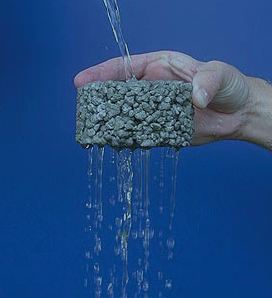

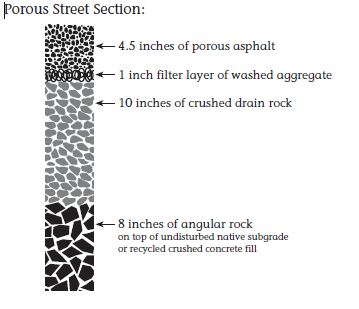
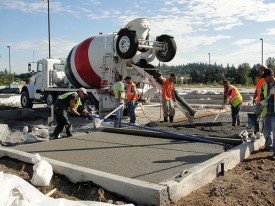
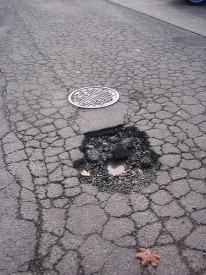
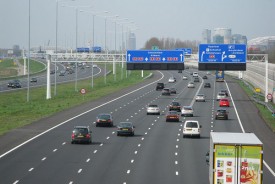







Brice Maryman
Seattle-ites can also see plenty of pervious concrete sidewalks and a pervious concrete road (32nd Ave SW) over at High Point in West Seattle.
Pam Emerson
Thank you for this, Lisa!
Matt from Texas
I think this would be a great idea, if the technology can be proven to hold up to common use and conditions. A good selling point for not only Seattle-ites, but also city and state DOT’s would be if this type of roadway could/would prevent the roadway from becoming icy. I didn’t live here in 2008 when the major winter storm hit, but I’ve heard the stories and seen pictures and videos on the Internet. I was here for that dustibg we got in November of 2010, and I remember trying to get home, and my SUV trying to go sideways here and there, despite the best efforts of it’s traction control.
If this pervious concrete can handle the job, it would certainly make our aging I-5 far easier to drive on during wet weather. (I-5 isn’t far from needing repaving as is.)
I’d like to know more about this, and more of what SDOT and WSDOT have to say about this new technology, and its viability.
Noel
“A good selling point for not only Seattle-ites, but also city and state DOT’s would be if this type of roadway could/would prevent the roadway from becoming icy.”
Yes, porous pavement is much better in icy conditions. In my experience, they don’t ice up and when the snow pack on traditional roads is getting real slick and slippery, the porous roads just soak the water up. I haven’t seen any studies that support this, but I’m sure they’re out there.
Tom
Thanks for some great research and clear writing. You’ve answered several lingering questions.
Like other Low Impact Development (LID) techniques, pervious pavement requires thoughtful planning and design. It may have higher upfront costs (though as you point out, it may also eliminate the need for costly containment and drainage infrastructure. And it requires maintenance (just like conventional stormwater technology). But these practices are not rocket science. They simply require a shift in the engineering culture. When they are well-known and institutionalized they will be hugely effective in solving expensive and thorny stormwater problems of high flow and toxic loading.
Callie Jordan
It’s a good thing that installation costs are less (or offset) by the savings on curbs and stormwater management devices, because the savings related to stormwater pollution are paid by a different budget department and/or externalized entirely to be paid by the waters themselves.
I always wondered what caused potholes. I always assumed they were somehow inevitable. If it’s a construction problem, why is patching them over and over again better than addressing the underlying cause.
Lisa Stiffler
Thanks for all of the great feedback. Looks like there’s still much more to say about this issue, and more questions to be answered.
And yes, Brice is right about some great examples of permeable pavement in Seattle’s High Point development.
One of my favorite patches of porous asphalt is at Piper Village, a little shopping area near Greenwood Ave in Northwest Seattle.
Dave Peeler
THis is a great article, Lisa. Thanks for pulling all this information together and addressing many of the commonly asked questions about permeable pavement. As higher standards for treatment and control of stormwater runoff kick in, I believe we will see more and more builders, developers and highway departments use permeable pavement wherever they can as it will be cheaper and take up less space than building off-road or off-site stormwater treatment facilities. And, it will contribute to a cleaner environment for people, fish and wildlife, while helping to restore Puget Sound and our watersheds.
pavan
hiii i am going to do on this porous roads can any one guide me the procedure
Charlie Cunniff
Nice article. There is a local manufacturer supplier of porous paving projects. Ultrablock has a subsidiary company called Xeripave. They are based in Vancouver, WA with offices in Seattle. They have done local projects; I am getting some referrals from them. http://www.xeripave.com/xeripave_002.htm
Jeff Youngstrom
I ride my bike on the pervious section of Rainier here in Issaquah. In rainy conditions it points out how much of getting wet while riding comes from the road vs. the sky. Love the stuff!
Rein Attemann
Thank you Lisa for this great article to debunk the myth that permeable pavement is not a proven Low Impact Development tool. Currently, the WA Dept of Ecology is gathering public input on this very issue, adopting Low Impact Development Standards for developers and new updated stormwater permits for cities. I encourage readers to take a moment to immediately send their comment to Ecology expressing support for strong permit language and standards. Just go to http://ow.ly/617jc to send your email comment. Thank you!
David Hymel
Great article Lisa. There is also an interesting pervious pavement project for its size and visibility in Pierce County, at Canyon Crossing shopping center, 176th St and Canyon near Puyallup. There is about 72,000 square feet (1.6 acres) of pervious parking and service road. The concrete finish is first rate and worth the visit to see a very well done installation.
http://www.concretemaninc.com/176th-and-canyon-retail/
Stewardship Partners also has a map website dedicated to these kinds of projects: http://g.co/maps/n4fv2
Alan Durning
Cool map, David Hymel. Thanks!
Rob Harrison AIA
Closer to downtown Seattle, there’s a nice spread of rice-crispy concrete at South Lake Union’s Maritime Center–all around the model boat sailing pond.
Becca Hanson FASLA
Woodland Park Zoo’s new Humboldt penguin habitat is surrounded by porous concrete pavement that has been in place for two+ years. That, coupled with the fact that the pool for the penguins is a closed loop system that uses rainwater for top-up and biofiltration to treat the backwash from the pool filters and return it into the system, means that nothing is going into the City’s storm water system and ultimately into Puget Sound.
Jesse Kocher
Sounds like they don’t get destroyed by freezing, but why not?
Seems like water would get in there, freeze, expand, and break up all the bonds in that lattice structure. Anybody know how they survive that?
Lisa Stiffler
Great question. The short answer is it appears that the water isn’t entirely filling the pockets and that there’s room for the water to expand into.
The folks at the University of New Hampshire have invested some time into researching how pervious pavement and other green stormwater strategies perform in cold regions. They rave about the pavement’s performance in this article titled: “Porous Asphalt Pavements for Stormwater Management in Cold Climates.”
They also note that the snow and ice melt faster on the porous surface because while it freezes, it doesn’t freeze as a solid block.
The UNH researchers said the porous asphalt actually lasts longer than conventional asphalt because it has “reduced freeze-thaw susceptibility.”
David Liguori
Lisa/Jesse,
If I may, I can address Jesse’s question in more detail.
As Lisa mentioned there is room for expansion to take place. Pervious concrete has approx 20% voids by design, but the expansion rate of freezing water is only about 9% so there is in effect “room to grow.” This extra space eliminates much of, but not all, the potential internal stress.
Here is the fail safe though. In an area with reasonably well draining soils the water never actually accumulates in the pervious concrete, it soaks into the ground before it has a chance to freeze. In areas with poor draining soils (clay) we design the system such that water is temporarily stored in an underlying layer of crushed drain rock giving it time to slowly infiltrate.
Feel free to peruse my website for more information
bayareaperviousconcrete.com
Emmitt
The pavement is drained to the rock below. Imagine a strainer when you dump spaghetti in, the water falls through the strainer and the spaghetti holds no water. However, if under designed or ground water is high in the area, water will infiltrate the permeable pavement where freeze thaw will be allowed to bust it up.
Vince Caruso
Here in Ann Arbor we are trying to get the city to move to using more porous in a Green Streets effort. We have one porous street now and more on the way, and some parking lots, some at the Univ. of Michigan.
Some other big advantages: reduce heat island (EPA calls it ‘cool pavement’, looks like grass on infrared), detoxifies pollution nearly 100% as it moves thru the matrix, great for trees along roads, 75% less salt needed, no black ice, no road spray and much less noise (highway noise wall alternative).
Some communities are using porous roadways just to reduce noise, up to 70%, in urban areas.
Philly has agreed to do city streets with it to meet new EPA agreements. EPA thinks other urban center should take notice. Chicago is doing 1,000 miles of service allies in porous to reduce flooding and pollution to Lake Michigan. Bangor Maine is planning on doing it’s downtown streets with it; talk about cold weather use.
Pringle Creek was reported to have saved $250,000 using porous over conventional pavement.
Many other towns in the US, large and small, have recently committed to do porous on roadways for all these great benefits.
It may save our community from major flood hazard and extensive pollution flowing into the Huron River which flows to Lake Erie.
Lisa Stiffler
Thanks, Vince, for the added info on the non-stormwater benefits. I’m eager to delve further into these other aspects of permeable pavement. If anyone has favorite sources for hard data on these attributes — less ice and salt, quieter roads, etc. — please post them or contact me!
Bernie Alonzo
Hi,
Interesting article.
Does anybody out there have any experience (good or bad) scoring permeable concrete paving?
In large areas (very wide side walks) the scale of the concrete gets monotonous.
I am looking for recommendations on scoring the paving to break down the scale to the pedestrian level without adversely affecting the performance of the concrete.
Saw cutting and tooled joints don’t work so, what does?
Bernie
Maggie
One problem: water freezes. Freezing water busts up roads, and the layer they just put on here drives like gravel.
Maggie
No to mention, larger chunks in the blacktop do not spread thin enough for transitions. It’s a mess. It’s ugly, it’s not even, and it looks like a bad blacktop job. Our driveway is a mess from it. Our new roadway locally is a mess. I would get blacktop again from this company.
Neetu yadav
Hi,
Its really very nice article and specially in pavement applications it proves to be like blessing for construction industry. It’s true that it require still awareness and research to improve its properties so it become one of widely us material like asphalt and concrete for road construction.
Mike Groves
Our neighborhood had pervious asphalt installed in 2006 prior to the Oregon Planned Community being built, but evidently, according to a company we asked to demo their cleaning system, it has become compacted over just this 9 year period to 2015. In other words, we’re drowning in water, and there doesn’t seem to be an inexpensive fix. Suggestions?
Josh Baldwin
Hi Mike,
I know for regular asphalt, it’s considered to be limited lifespan product that eventually requires overlay and replacement, probably more at a 25 year lifespan. I’m guessing you can’t do an overlay on pervious though. One problem that I’ve heard with pervious asphalt is that its more susceptible to grinding off the top layer, for example, in a parking lot where cars are often turning their wheels while stopped instead of while moving like on a road (this came from a friend who is in charge of a pervious parking lot). An additional problem is it susceptibility to heat. I had an architect tell me that they did a LEED home with a pervious driveway that basically melted on a record hot day.
Probably your cheapest fix is installing some stormwater management along the edges of the road, gutters, catch basins, etc. You might want to compare that to having someone pull up the asphalt and put down pervious concrete as a comparison.
Marc Marin
Miss Stiffler,
What is your opinion about pervious pavement in colder climate, when we use sand or salt.
Thanks in advance
Emmitt
Cahill industries the inventors of permeable pavement suggest you not sand or gravel, it will clog the pours. You can salt. It cannot be used on hills where the grade is more then 5%.
Emmitt
If we are going to start using permeable pavement in the State of Washington, I believe it is time to outlaw studded tires. Studded tires and chains will break down the lattice structure of the pavement and scoring of the surface degrades it ability to drain.
James Bergman
I really like the idea of using porous asphalt. If it keeps most of the harmful runoff away from our waterways then it is a really good thing. However, I do worry about its applications in colder climates. Will snowmelt get caught in the porous asphalt and make it crack? If so then colder climate may not be suitable for this asphalt.
jonah
hi